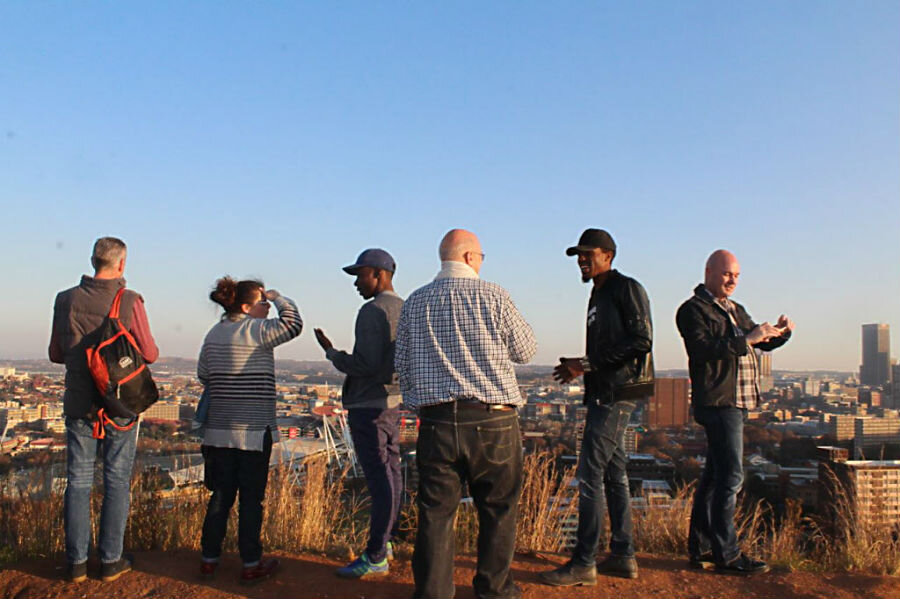Johannesburg tours reintroduce residents to the city they grew up in
Loading...
| Johannesburg
On a ridge high above downtown Johannesburg, tour guide James Manguza turns his back to the jumble of modernist skyscrapers below and begins teaching his crash course in the history of the inner city.
It’s a tale of starry-eyed gold prospectors and roving gangsters, of the testosterone-fueled cosmopolitanism of a 19th-century frontier town, where men of all races were united by a single ambition: money.
But as the story winds through the last century, it grows darker. Mr. Manguza describes the rise of apartheid and the sharp racial lines it drew across a once mixed city, with black families evicted to distant, segregated suburbs, far from the city’s economic heart.
In front of Mr. Manguza, his charges, all of whom are white, begin to nod solemnly. This part of the story, they remember.
Manguza is describing the Johannesburg where they grew up, a city where race dictated everything from the park bench you sat on to the hospital where you were born and the neighborhoods in which you were allowed to live.
That’s a history that still courses through Johannesburg’s present. And it means that although everyone on this tour has lived in the city most of their lives, none of them have been to this part of town in nearly 30 years, since it began its slow drift from a mostly-white residential suburb to a nearly entirely black one.
“South Africans live in a bubble,” Manguza says later, as he leads the group down a busy artery, where Ethiopian restaurants jostle up against bars thumping Congolese pop music and tiny corner shops selling highlighter-red palm oil and gnarled West African yams.
The tour they’re on focuses on the culinary offerings of this immigrant-heavy neighborhood, Yeoville. “Because of the crime, people live with the paranoia that everyone is out to get them,” he says. “What we’re trying to do is get people out, show them their neighbors.”
Manguza, a Congolese immigrant who has lived in this part of Johannesburg since he was 8, works for a company called Dlala Nje, which offers walking tours of two inner-city Johannesburg neighborhoods – Yeoville and Hillbrow – that have long been considered no-go zones for the city’s tourists and suburbanites alike.
Over the past few years, the number of “alternative” city tours in Johannesburg like this one has mushroomed, giving both locals and tourists the chance to tour everything from graffiti to urban swimming pools to Africa’s tallest apartment building.
Entering 'forbidden' places
Below their diverse surfaces, these tours have a common theme, says Heather Mason, a Johannesburg-based travel writer and blogger. They give people permission to step into places in this deeply divided city that history, custom, and paranoia have long dictated they stay far away from.
“There’s a specific appeal to these tours in Johannesburg because it’s a city with so many places people still perceive as forbidden,” Ms. Mason says.
Those perceptions are beginning to shift.
In the run-up to the 2010 World Cup, the city began pouring money into the “renewal” of the inner city – and private developers followed, transforming swaths of real estate from derelict warehouses to blocks of coffee shops and artists’ lofts.
Johannesburg – long cast in guidebooks as gritty and unsafe, a necessary but unfortunate stopover en route to safari parks and beach vacations – began to earn bewildered accolades from the travel sections of papers like The New York Times, who called it “one of Africa’s most thrilling metropolises” in a 2012 piece.
But if those changes have been appealing to international visitors, they’ve had a decidedly mixed impact on Johannesburg residents – a fact Sifiso Ntuli never fails to highlight on his tours of the western corridor of the city. The streets may be safer, he says, but for whom – the black people who walk them, or the white people who have long been too afraid to?
'Apartheid isn't a museum'
Mr. Ntuli, an engineer and restaurateur, spent a decade in exile from the apartheid government, and his tour is unflinching in its critiques of both the country’s past and present.
“People who come to this city often visit our apartheid museum – but apartheid isn’t a museum. It’s alive, it’s well,” he says, referring to South Africa’s gaping levels of inequality, which are among the highest in the world.
For Salma Patel, too, the purpose of taking people on tours of the city is to excavate its painful history, not bury it. Her own tour zig-zags across Fietas, a once racially mixed neighborhood west of the city center that was blighted in the 1970s by one of South Africa’s infamous “forced removals,” which took aim at mixed areas of the city by marking them as slums and scattering their residents to distant, segregated peripheries.
Her own family fought the removal, and today she lives in a house wedged between open lots piled with rubble – sites where homes were destroyed and simply never rebuilt.
“I don’t think of myself as just a tour guide,” she says. “This is my own life. It’s my own journey.”
Back in Yeoville, the tour group ambles toward its last stop – a Cameroonian restaurant serving up grilled fish and heaps of hot fried plantains. One of the men remarks that the atmosphere reminds him of other African cities he’s visited – a frenetic, lively hustle that seems to continue around the clock.
But then he sees the old colonial buildings and the street names he remembers from childhood, he says, and he realizes with surprise that he’s not far from home.






